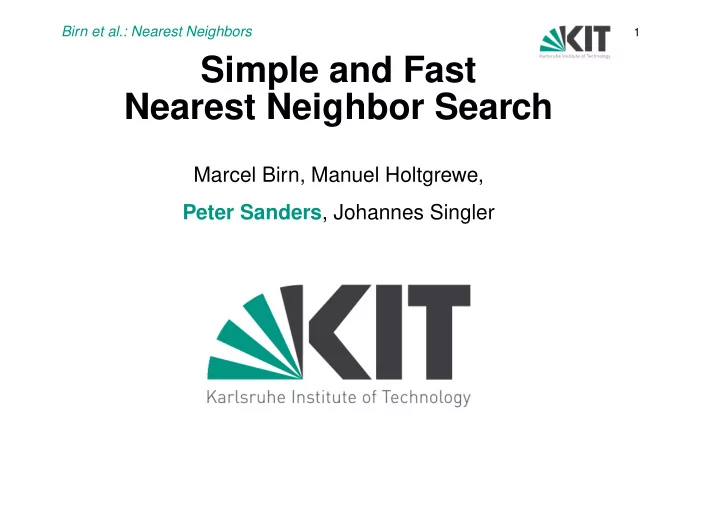

Birn et al.: Nearest Neighbors 1 Simple and Fast Nearest Neighbor Search Marcel Birn, Manuel Holtgrewe, Peter Sanders , Johannes Singler
Birn et al.: Nearest Neighbors 2 2D Nearest Neighbor Search Preprocess S = { ( x 1 , y 1 ) , . . . , ( x n , y n ) } . Query: q = ( x, y ) − → closest point in S (Euclidean distance)
Birn et al.: Nearest Neighbors 3 Application Example Geographic Information Systems, e.g., Route Planning
Birn et al.: Nearest Neighbors 4 A Greedy Algorithm Preprocessing: Delaunay Triangulation (not Yao graph etc. !) Query: Start at any point in S . Follow any edge towards q . Iterate until no improvement possible. still linear time. . .
Birn et al.: Nearest Neighbors 5 Multiple Levels Start with a sample of points from S . Closest point in sample → starting point in next level. � How many levels? � Complicated data structure?
Birn et al.: Nearest Neighbors 6 n Levels? Randomly number points in S . Function nlevelNN ( q ) 5 3 8 1 6 4 2 7 u := s 1 for i := 1 to n do u := greedyNN ( u, q, DT ( s 1 ..k )) return u Sounds like quadratic space and at least linear time???
Birn et al.: Nearest Neighbors 7 Full Delaunay Hierarchy (FDH) n � G := (1 ..n, E k ) i =1 where G k = (1 ..k, E k ) := Delaunay triangulation of points 1 ..k . 5 3 8 1 6 4 2 7 5 3 8 1 6 4 2 7 G has a linear expected number of edges e.g., [Guibas et al. 92].
Birn et al.: Nearest Neighbors 8 FDH-Based n Level Search! Procedure nn ( q, { s 1 , . . . , s n } ) u := s 1 repeat foreach neighbor v of u in G with u > v in increasing order do invariant u is nearest neighbor of q wrt 1 ..v − 1 if || q − s v || 2 < || q − s u || 2 then 5 3 8 1 6 4 2 7 u := v break for loop until no improvement found return u
Birn et al.: Nearest Neighbors 9 Analysis Theorem: Expected number of nodes visited ≤ ln n + 1 Proof Idea: s i is visited ⇔ s i is closest to q wrt 1 ..i . This event has probability 1 /i . � harmonic sum � claim. i
Birn et al.: Nearest Neighbors 10 Bad Inputs # of inspected edges might be Ω ( n )
Birn et al.: Nearest Neighbors 11 Implementation Store coordinates redundantly in edge array. � Scan logarithmic number of pieces. � Never worse than greedy scanning algorithm. x: 1 2 3 4 5 6 7 8 5 3 8 1 6 4 2 7 #: q=(2.8, 0) 1 2 3 4 2(7,0) 3(2,0) 4(6,0) 6(5,0) 8(3,0) 4(6,0) 7(8,0) 5(1,0) 8(3,0) 6(5,0)
Birn et al.: Nearest Neighbors 12 Other Approaches optimal kd−Tree Delaunay Hierarchy Voronoi Diagram currently preferred relatively complicated +point location in practice implementation? [CGAL, Mount et al.] [Devillers92]
Birn et al.: Nearest Neighbors 13 Instances [Devillers02] 95% 5% on parabola mixed in square on circle
Birn et al.: Nearest Neighbors 14 Experiments: Square 10 time per query [ µ s] 1 CGAL Delaunay hierarchy FDH exact ANN kd-tree CGAL kd-tree FDH array, inexact 0.1 2 11 2 13 2 15 2 17 2 19 2 21 2 23 128 512 number of points (n)
Birn et al.: Nearest Neighbors 15 Experiments: Circle (parabola similar) 10 4 ANN kd-tree CGAL Delaunay hierarchy CGAL kd-tree 1000 FDH, exact FDH, inexact time per query [ µ s] 100 10 1 0.1 2 11 2 13 2 15 2 17 2 19 2 21 2 23 128 512 number of points (n)
Birn et al.: Nearest Neighbors 16 Experiments: Mixed 1000 ANN kd-tree CGAL Delaunay hierarchy CGAL kd-tree FDH, exact 100 FDH, inexact time per query [ µ s] 10 1 0.1 2 11 2 13 2 15 2 17 2 19 2 21 2 23 128 512 number of points (n)
Birn et al.: Nearest Neighbors 17 More Related Work � Several n -level geom. data structures on more complex objects (triangles. . . ) and for point location. [BoissonatTeillaud86], [Guibas et al. 92],. . . � Contraction Hierarchies – route planning with n levels [Geisberger et al. 2008] � n -level Graph Partitioning [with Vitaly Osipov]
Birn et al.: Nearest Neighbors 18 Conclusions Full Delaunay Hierarchies � (mostly) fast � simple � elegant
Birn et al.: Nearest Neighbors 19 Open Problems � Comparison with worst case efficient algorithms � Make worst case efficient, e.g., replace high degree nodes? move high degree nodes in hierarchy? � Higher Dimensions??? � More n -level algorithms?
Recommend
More recommend